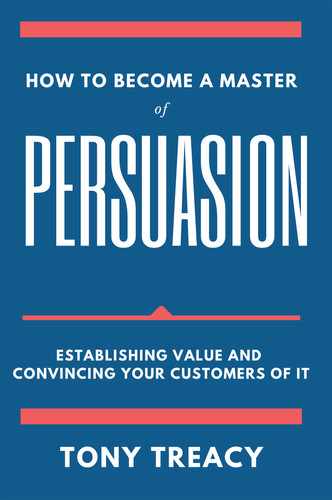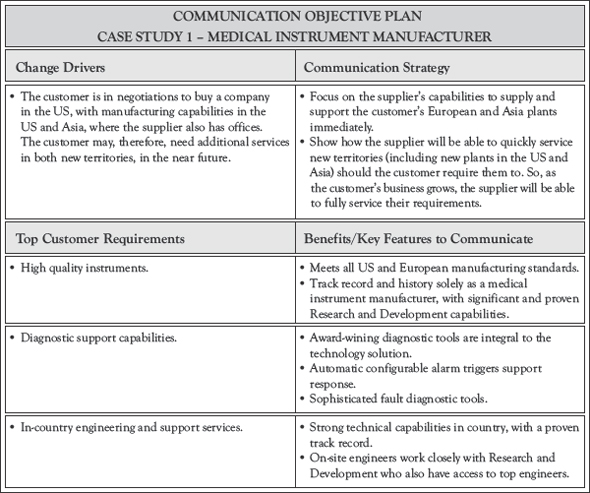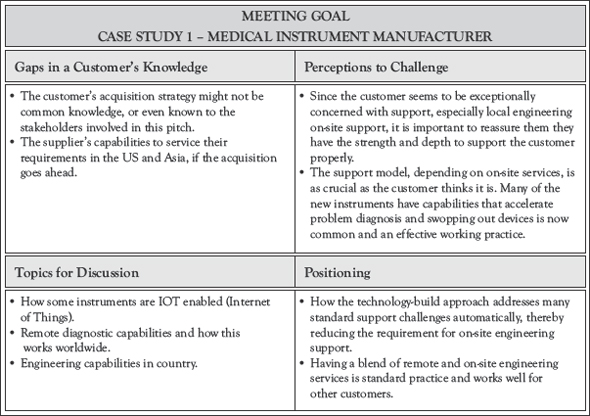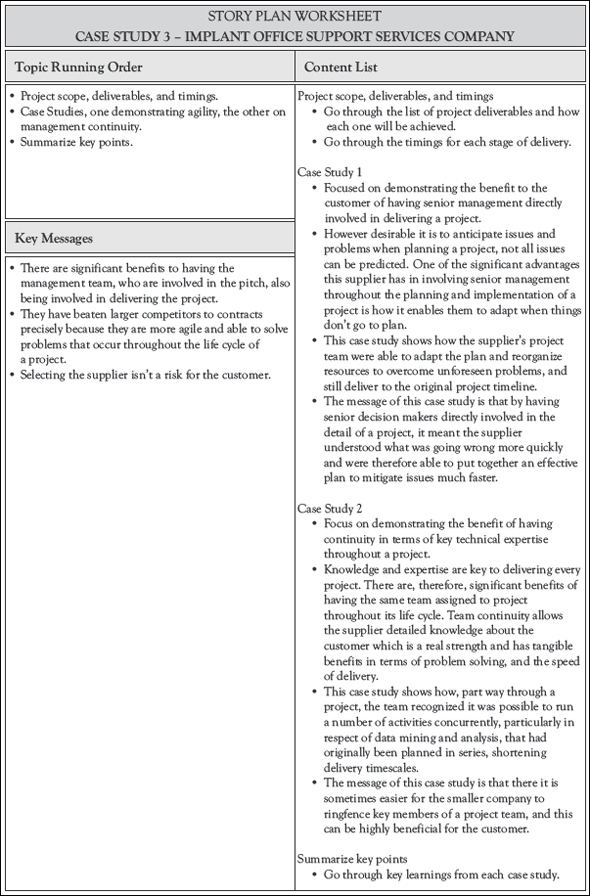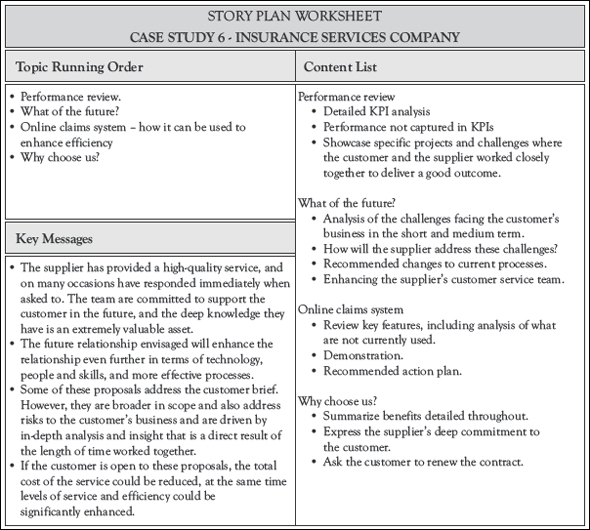The following pages contain six case studies which are based on real examples taken from a number of consultancy projects. The case studies focus on the challenges facing six different suppliers, all of whom work in different industries, and are preparing for meetings with a customer at key stages of the sales process.
Case Study 1—Medical Instrument Manufacturer
Scenario—Positioning to Service the Customer’s Current and Future Plans
This case study shows how profiling can have a significant impact on the way a supplier positions themselves. On researching the customer, the supplier learns that the customer is in negotiation to buy an American competitor. They see the potential of being able to service the customer in the future in the new territories and recognize this might help to win the current contract, which is only focused on the customer’s current business footprint.
Case Study 2—Implant Office Support Services Company
Scenario—Changing the Delivery Strategy
This case study describes the situation where a supplier realizes their assumptions have led them to propose an unworkable solution, and therefore, they now need to change their entire approach if they are to be successful. The question for them is, how should they present this to the customer?
Case Study 3—IT Solution Provider to the Public Sector
Scenario—Challenging Customer Misconceptions
In this case study, the supplier recognizes their biggest obstacle to winning is that their customer doesn’t appreciate the extent of their capabilities. Unless they can challenge current perceptions that they are too small to meet the requirements the customer has set out, they stand little chance of winning.
Case Study 4—Confectionary Packaging Industry Supplier
Scenario—Addressing Customer Relationship Issues
In this case study, a supplier has a relationship problem to deal with. The relationship between the leader of their customer service team and the customer has ceased to work well. They may need to change the team leader in order to build a more positive (and potentially winning) relationship with a customer.
Case Study 5—Technology Solutions Provider to the Finance Sector
Scenario—Pitch Strategy: Cost Savings or Realistic Outcomes?
This case study describes the scenario faced by a software supplier whose analysis shows how the solution they have proposed will both save money but also lead to redundancies, and how they prepare for the final presentation to a broad management team, including the department heads who will lose staff if the project goes ahead.
Case Study 6—Insurance Services Company
Scenario—Pitching to Retain a Service Contract
This case study describes the approach taken by the incumbent insurance services supplier whose customer has put the service they provide out to tender.
Case Study 1—Medical Instrument Manufacturer
Scenario—Positioning to Service the Customer’s Current and Future Plans
The supplier is a global medical instrument manufacturer tendering to provide testing equipment and support services to a large pharmaceutical company with manufacturing sites in a number of countries in Europe.
The customer has issued a request for proposal (RFP) for a major contract and invited the supplier to put forward a proposal. One of the key requirements raised in the RFP is the importance of the supplier having a proven track record in delivering remote diagnostic services as part of a broad technical support package. It is clear the package is extremely important to the customer, who has explicitly requested the supplier is able to provide on-site engineering services rapidly, if required, and that service will be governed by short response and fix turnaround times to be covered in contractual service level agreements.
Following an initial briefing, attended by other suppliers and a meeting with the procurement department where they presented their company credentials, the supplier has made it onto the shortlist of suppliers and been asked to come to the European headquarters to present their solution to senior management.
On researching the customer, the supplier came across a news story on a business news portal that reported the customer was in negotiations to buy an American competitor, which has manufacturing facilities in the United States, as well as across Asia (Figure 5.1).
The RFP is focused only on purchasing equipment and services in Europe and has made no mention of the U.S. acquisition. However, since the supplier has offices in the United States and Asia, as well as Europe, it sees the potential of being able to fully service the customer in the new territories as well, should the acquisition go ahead. It is, therefore, important the customer recognizes their full global capabilities.
Although the expansion of the customer’s business footprint may lead to a future business opportunity for the supplier to supply these new territories, whether they can use this knowledge to help them to differentiate themselves from other companies involved in the current tender depends on them being able to discuss the acquisition with the customer.
Figure 5.1 Case study 1—Communication Objective Plan
As they prepare for the pitch and complete the Meeting Goal, the supplier is mindful that it isn’t clear how much information about the acquisition is in the public domain, and they don’t want to do anything that potentially damages the relationship with the existing European-based customer. Therefore, the team needs to be careful they don’t pitch to provide a service that hasn’t been requested by the customer. However, that doesn’t mean they shouldn’t communicate their global capabilities (Figure 5.2).
A key focus of the presentation will be to reassure the customer that the supplier has the capabilities to provide excellent service and meet the SLAs set by the customer. However, the approach being taken in terms of support is out of date in terms of the way new technology is being manufactured with a number of features that handle self-diagnosis, automatic alerts to the supplier’s support desk, and can be replaced and swopped out easily and quickly. It is important to get this across.
Also, in respect of the element of caution about the pending acquisition, rather than overtly talk about this to the customer, the plan is to showcase how the supplier has a global footprint that already supports customers; and this will provide the opportunity for the pitch team to point out how they already run global services for other customers effectively.
Figure 5.2 Case study 1—Meeting Goal
The meeting will provide the opportunity for questions and answers, and the acquisition may be something that comes up then, in which case the supplier will be able to explain how it can develop the services currently under discussion to cover new territories very quickly and easily, if that is what the customer needs them to do (Figure 5.3).

Figure 5.3 Case study 1—Story Plan worksheet
Supplier 2—Implant Office Support Services Case Study
Scenario—Changing the Delivery Strategy
The company provides implant office support services to major corporations, which requires them to put staff on the ground in the offices of their customers to deliver a number of back-office services. The supplier was asked to respond to a tender document which, as normal, detailed the requirements of the customer. Since then, they have had a number of face-to-face meetings which led them to recommend a solution and outline a transition plan.
As they have got to know the customer better, what has become clear to the pitch team is that their approach is flawed. They made a number of assumptions that have turned out to be incorrect. This is a situation where, if they could turn the clock back, they would have tackled things very differently. However, they are where they are. They can, of course, keep going, but it is unlikely that what they have proposed can be delivered successfully (Figure 5.4).
This isn’t the first supplier to jump into answering a brief from a customer without doing their homework properly. Changing direction is a brave move and one that could be a make-or-break moment. The supplier is going to have to admit they got things wrong from the start. The question is what the customer will make of it? They could react badly, think the supplier has wasted a lot of their time, and exclude them from further participation in the tender process.

Figure 5.4 Case study 2—Meeting Goal
Figure 5.5 Case study 2—Story Plan worksheet
However, there is a potential upside. What if the customer sees this positively? What if, although no doubt unhappy the supplier has made a mistake, they actually appreciate their honesty? Could it be a very positive move, even a game changer, that transforms the relationship from one that has faltered into a winning one? (Figure 5.5).
Supplier 3—IT Solution Provider to the Public Sector
Scenario—Challenging Customer Misconceptions
This supplier provides IT solutions to the public sector and is mid-tier in size with a good track record. The customer is looking for someone to provide hosting and software services, and the supplier has discussed their requirements on a number of occasions. The supplier has all the technical accreditations required (e.g., from Microsoft and others), so there should be no suggestion they are unable to deliver the requirements in full. However, it has become clear to the supplier that the customer doubts whether the supplier has the scale to deliver what is required and favor the larger companies who have also been invited to pitch.

Figure 5.6 Case study 3—Meeting Goal
This is not the first time the supplier has met this obstacle. They know they are a smaller and younger business compared to the bigger blue-chip competitors they are up against. Inevitably, that means they have less experience to demonstrate and fewer case studies to put forward to reassure the customer.
However, they also know they have a number of advantages over some of the larger competitors. They have a track record of delivering solutions quickly and outperforming many key performance indicators, and they have won contracts before from customers when up against larger companies (Figure 5.6).
This is problem that has been around forever. How does a smaller challenger brand reassure the customer that they are large and experienced enough to do the job? The only way for the supplier to challenge the customer’s current perception is to openly discuss their concerns and use that discussion to get across the benefits and advantages they think they have compared to the larger companies (Figure 5.7).
Figure 5.7 Case study 3—Story Plan worksheet
Supplier 4—Confectionary Packaging Industry Supplier
Scenario—Addressing Customer Relationship Issues
This supplier provides packaging solutions to the confectionary industry and is involved in what has turned into an extended pitch process that has been stopped and started by the customer on a number of occasions for various reasons. The primary customer is a senior manager who is responsible for manufacturing on multiple sites and is someone with whom the supplier will have to work very closely on a daily basis if they are appointed. Due to the length of time, the pitch process has been running they have got to know the manager well and until recently felt they had built a good relationship.
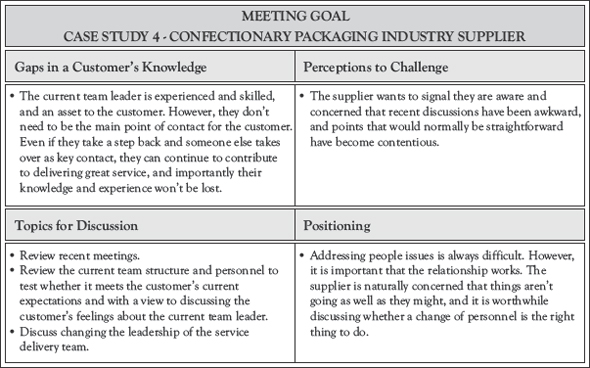
Figure 5.8 Case study 4—Meeting Goal
However, recently it has become clear that the relationship between the customer and the leader of the supplier’s customer service team has ceased to work well. Given it is clearly essential to have a strong and positive relationship with the customer, the supplier is concerned this will prevent them winning, unless they address the problem (Figure 5.8).
When service delivery is rooted in people relationships, it is essential for both the customer and supplier to get on. This isn’t about friendships, although that can happen over time. It is more about the chemistry between people, especially at a leadership level.
There will be times when things go wrong, and that is when the supplier needs a strong customer relationship to fall back on. If at this early stage the chemistry isn’t working, then it has to be fixed. Unless they do something, the supplier is very unlikely to win, especially as the key decision maker is also the customer with whom they perceive there to be a problem (Figure 5.9).

Figure 5.9 Case study 4—Story Plan worksheet
Supplier 5—Technology Solutions Provider to the Finance Sector
Scenario—Cost Savings or Realistic Impacts?
This supplier provides technology solutions to the finance sector whose customer, an international partnership based in over 25 countries, is looking to source a new IT solution to replace an outdated finance and time-management system. As well as integrating with a number of legacy systems, the new system will need to ingest and process large volumes of historical data. Analysis shows the new technology platform will streamline current processes and increase efficiency significantly. However, it will also lead to some redundancies in a number of departments.
Achieving the benefits will not be straightforward. The success of the project requires the customer and supplier team to manage a major restructuring program. This includes a major redundancy program as well as implementing an entirely new suite of software tools that will change roles and responsibilities across the entire company in multiple countries. However, at the same time, the business needs to carry on as usual and there is a significant risk to business continuity.
The supplier’s pitch team has reached the final pitch stage of a long procurement process. They have been asked to present to a large team of stakeholders, which includes senior management and the department heads who will be most affected by the changes. The supplier is concerned that not everyone has fully understood the work that will be necessary to implement the new system.
The question for the pitch team is where to focus? Do they headline the financial benefits of the project, thinking that management will like that message and appoint them; or do they go into the risks and the detail of delivering a project of this scale as well? They have managed similar projects before and believe demonstrating their expertise and experience is a key factor in being selected. However, they are worried that if they don’t address the challenges facing the project team as a whole, and focus only on the headline benefits, they will lose credibility with the wider audience who are not only involved in making the decision but are also heavily involved in implementation.
This is a common conundrum facing many suppliers. Management can sometimes latch onto the headline benefits and play down the scale of the work that will be required to achieve them.
The scale of the benefits in this case study, in part, reflects the customer’s underinvestment in the past. They are now taking a big step forward, which will enable them not only to catch up with competitors but also to take a step ahead. However, no one should doubt the importance of implementation in the overall success of the project. Getting it right is essential. Getting it wrong could be disastrous.
The supplier not only has to talk about implementation in detail but also has to factor the resources needed to deliver the project accurately into any fee proposal, as well as having detailed the commitment required from the customer. This is the reality of the project, and it is clearly to the benefit of both parties that they share an accurate understanding of the scope and scale of the project (Figures 5.10 and 5.11).
Figure 5.10 Case study 5—Meeting Goal
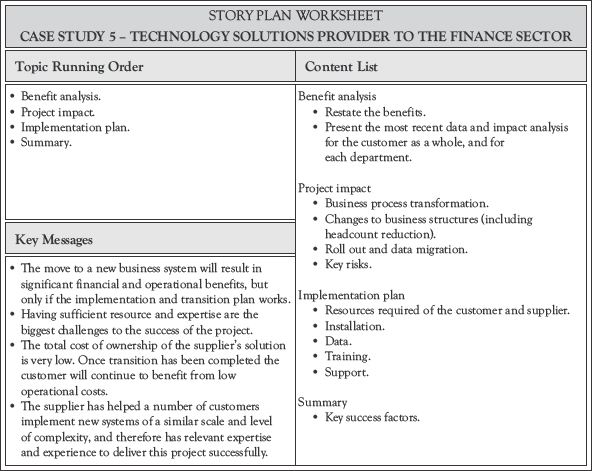
Figure 5.11 Case study 5—Story Plan worksheet
Supplier 6—Insurance Services Company
Scenario—Pitching to Retain a Service Contract
This supplier has provided insurance services to a large international corporate real estate customer for several years. As well as the insurance product itself, they also provide a back-office function that manages claims. They have been asked to pitch to retain the business in line with the customer’s new procurement policy.
In recent years, the supplier’s customer service team has changed substantially. The customer has also made a number of management changes too, and only recently appointed a new director to oversee the relationship with the supplier.
The customer has issued a brief asking the supplier, and several of their competitors, to put forward a proposal to supply the required products and services. The brief also asks suppliers to demonstrate innovative ideas as to how they could transform the efficiency and management of the insurance back-office services, and rather than manage the pitch process themselves have asked a specialist procurement consultant to run the process. The consultant has worked on several other pitches with the supplier, but they have never won a pitch managed by this consultant.
Overall, the supplier has provided an efficient and effective service. Service levels, as described in the current contract, have been met. The relationship is considered strong, but there was an occasion a year before when they had had to replace the customer service team leader after a falling out with the lead customer, who has also since moved on. There have also been a few complaints that the supplier hasn’t always answered e-mails quickly enough. Also, the customer hasn’t been fully using the online claims system, preferring to contact the supplier’s customer service team manually.
Although, at face value, this is common challenge and might appear easy to solve, in many ways, it is really challenging. The big difference between being the incumbent supplier and a potential new one is that a potential new supplier can offer the earth. They can make claims about the way they will work and how good they will be, without taking any risks because the customer, unlike with the incumbent, has no experience of working with them.
For the incumbent, everything is the opposite. Everything they say about themselves or promise to do will inevitably be compared to the experience the customer has had of them during the current contract. Of course, there are advantages too. There will be an existing relationship to leverage, and the knowledge the supplier holds about the customer will be much more detailed and insightful than any prospective supplier can have (Figures 5.12 and 5.13).
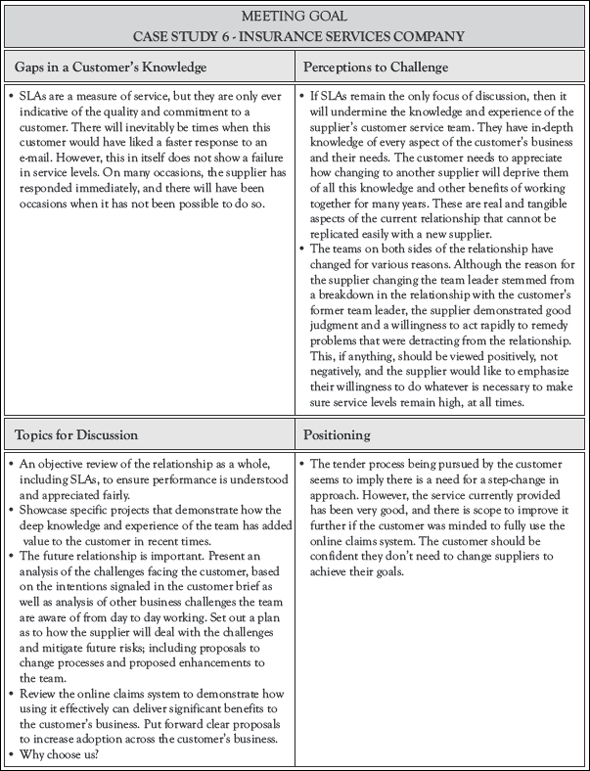
Figure 5.12 Case study 6—Meeting Goal
Figure 5.13 Case study 6—Story Plan worksheet
